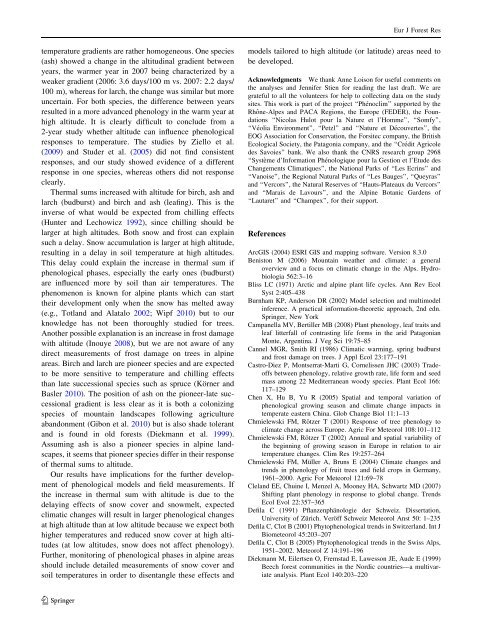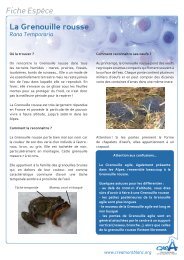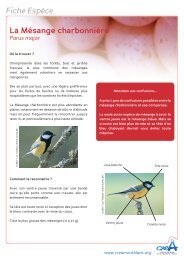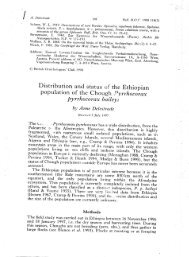European Journal of Forest Research. - CREA
European Journal of Forest Research. - CREA
European Journal of Forest Research. - CREA
Create successful ePaper yourself
Turn your PDF publications into a flip-book with our unique Google optimized e-Paper software.
Eur J <strong>Forest</strong> Res<br />
temperature gradients are rather homogeneous. One species<br />
(ash) showed a change in the altitudinal gradient between<br />
years, the warmer year in 2007 being characterized by a<br />
weaker gradient (2006: 3.6 days/100 m vs. 2007: 2.2 days/<br />
100 m), whereas for larch, the change was similar but more<br />
uncertain. For both species, the difference between years<br />
resulted in a more advanced phenology in the warm year at<br />
high altitude. It is clearly difficult to conclude from a<br />
2-year study whether altitude can influence phenological<br />
responses to temperature. The studies by Ziello et al.<br />
(2009) and Studer et al. (2005) did not find consistent<br />
responses, and our study showed evidence <strong>of</strong> a different<br />
response in one species, whereas others did not response<br />
clearly.<br />
Thermal sums increased with altitude for birch, ash and<br />
larch (budburst) and birch and ash (leafing). This is the<br />
inverse <strong>of</strong> what would be expected from chilling effects<br />
(Hunter and Lechowicz 1992), since chilling should be<br />
larger at high altitudes. Both snow and frost can explain<br />
such a delay. Snow accumulation is larger at high altitude,<br />
resulting in a delay in soil temperature at high altitudes.<br />
This delay could explain the increase in thermal sum if<br />
phenological phases, especially the early ones (budburst)<br />
are influenced more by soil than air temperatures. The<br />
phenomenon is known for alpine plants which can start<br />
their development only when the snow has melted away<br />
(e.g., Totland and Alatalo 2002; Wipf 2010) but to our<br />
knowledge has not been thoroughly studied for trees.<br />
Another possible explanation is an increase in frost damage<br />
with altitude (Inouye 2008), but we are not aware <strong>of</strong> any<br />
direct measurements <strong>of</strong> frost damage on trees in alpine<br />
areas. Birch and larch are pioneer species and are expected<br />
to be more sensitive to temperature and chilling effects<br />
than late successional species such as spruce (Körner and<br />
Basler 2010). The position <strong>of</strong> ash on the pioneer-late successional<br />
gradient is less clear as it is both a colonizing<br />
species <strong>of</strong> mountain landscapes following agriculture<br />
abandonment (Gibon et al. 2010) but is also shade tolerant<br />
and is found in old forests (Diekmann et al. 1999).<br />
Assuming ash is also a pioneer species in alpine landscapes,<br />
it seems that pioneer species differ in their response<br />
<strong>of</strong> thermal sums to altitude.<br />
Our results have implications for the further development<br />
<strong>of</strong> phenological models and field measurements. If<br />
the increase in thermal sum with altitude is due to the<br />
delaying effects <strong>of</strong> snow cover and snowmelt, expected<br />
climatic changes will result in larger phenological changes<br />
at high altitude than at low altitude because we expect both<br />
higher temperatures and reduced snow cover at high altitudes<br />
(at low altitudes, snow does not affect phenology).<br />
Further, monitoring <strong>of</strong> phenological phases in alpine areas<br />
should include detailed measurements <strong>of</strong> snow cover and<br />
soil temperatures in order to disentangle these effects and<br />
models tailored to high altitude (or latitude) areas need to<br />
be developed.<br />
Acknowledgments We thank Anne Loison for useful comments on<br />
the analyses and Jennifer Stien for reading the last draft. We are<br />
grateful to all the volunteers for help to collecting data on the study<br />
sites. This work is part <strong>of</strong> the project ‘‘Phénoclim’’ supported by the<br />
Rhône-Alpes and PACA Regions, the Europe (FEDER), the Foundations<br />
‘‘Nicolas Hulot pour la Nature et l’Homme’’, ‘‘Somfy’’,<br />
‘‘Véolia Environment’’, ‘‘Petzl’’ and ‘‘Nature et Découvertes’’, the<br />
EOG Association for Conservation, the Forsitec company, the British<br />
Ecological Society, the Patagonia company, and the ‘‘Crédit Agricole<br />
des Savoies’’ bank. We also thank the CNRS research group 2968<br />
‘‘Système d’Information Phénologique pour la Gestion et l’Etude des<br />
Changements Climatiques’’, the National Parks <strong>of</strong> ‘‘Les Ecrins’’ and<br />
‘‘Vanoise’’, the Regional Natural Parks <strong>of</strong> ‘‘Les Bauges’’, ‘‘Queyras’’<br />
and ‘‘Vercors’’, the Natural Reserves <strong>of</strong> ‘‘Hauts-Plateaux du Vercors’’<br />
and ‘‘Marais de Lavours’’, and the Alpine Botanic Gardens <strong>of</strong><br />
‘‘Lautaret’’ and ‘‘Champex’’, for their support.<br />
References<br />
ArcGIS (2004) ESRI GIS and mapping s<strong>of</strong>tware. Version 8.3.0<br />
Beniston M (2006) Mountain weather and climate: a general<br />
overview and a focus on climatic change in the Alps. Hydrobiologia<br />
562:3–16<br />
Bliss LC (1971) Arctic and alpine plant life cycles. Ann Rev Ecol<br />
Syst 2:405–438<br />
Burnham KP, Anderson DR (2002) Model selection and multimodel<br />
inference. A practical information-theoretic approach, 2nd edn.<br />
Springer, New York<br />
Campanella MV, Bertiller MB (2008) Plant phenology, leaf traits and<br />
leaf litterfall <strong>of</strong> contrasting life forms in the arid Patagonian<br />
Monte, Argentina. J Veg Sci 19:75–85<br />
Cannel MGR, Smith RI (1986) Climatic warming, spring budburst<br />
and frost damage on trees. J Appl Ecol 23:177–191<br />
Castro-Diez P, Montserrat-Marti G, Cornelissen JHC (2003) Trade<strong>of</strong>fs<br />
between phenology, relative growth rate, life form and seed<br />
mass among 22 Mediterranean woody species. Plant Ecol 166:<br />
117–129<br />
Chen X, Hu B, Yu R (2005) Spatial and temporal variation <strong>of</strong><br />
phenological growing season and climate change impacts in<br />
temperate eastern China. Glob Change Biol 11:1–13<br />
Chmielewski FM, Rötzer T (2001) Response <strong>of</strong> tree phenology to<br />
climate change across Europe. Agric For Meteorol 108:101–112<br />
Chmielewski FM, Rötzer T (2002) Annual and spatial variability <strong>of</strong><br />
the beginning <strong>of</strong> growing season in Europe in relation to air<br />
temperature changes. Clim Res 19:257–264<br />
Chmielewski FM, Müller A, Bruns E (2004) Climate changes and<br />
trends in phenology <strong>of</strong> fruit trees and field crops in Germany,<br />
1961–2000. Agric For Meteorol 121:69–78<br />
Cleland EE, Chuine I, Menzel A, Mooney HA, Schwartz MD (2007)<br />
Shifting plant phenology in response to global change. Trends<br />
Ecol Evol 22:357–365<br />
Defila C (1991) Pflanzenphänologie der Schweiz. Dissertation,<br />
University <strong>of</strong> Zürich. Veröff Schweiz Meteorol Anst 50: 1–235<br />
Defila C, Clot B (2001) Phytophenological trends in Switzerland. Int J<br />
Biometeorol 45:203–207<br />
Defila C, Clot B (2005) Phytophenological trends in the Swiss Alps,<br />
1951–2002. Meteorol Z 14:191–196<br />
Diekmann M, Eilertsen O, Fremstad E, Lawesson JE, Aude E (1999)<br />
Beech forest communities in the Nordic countries—a multivariate<br />
analysis. Plant Ecol 140:203–220<br />
123



![[pdf] Fiche Relais Phénoclim - CREA](https://img.yumpu.com/51248032/1/184x260/pdf-fiche-relais-phacnoclim-crea.jpg?quality=85)






